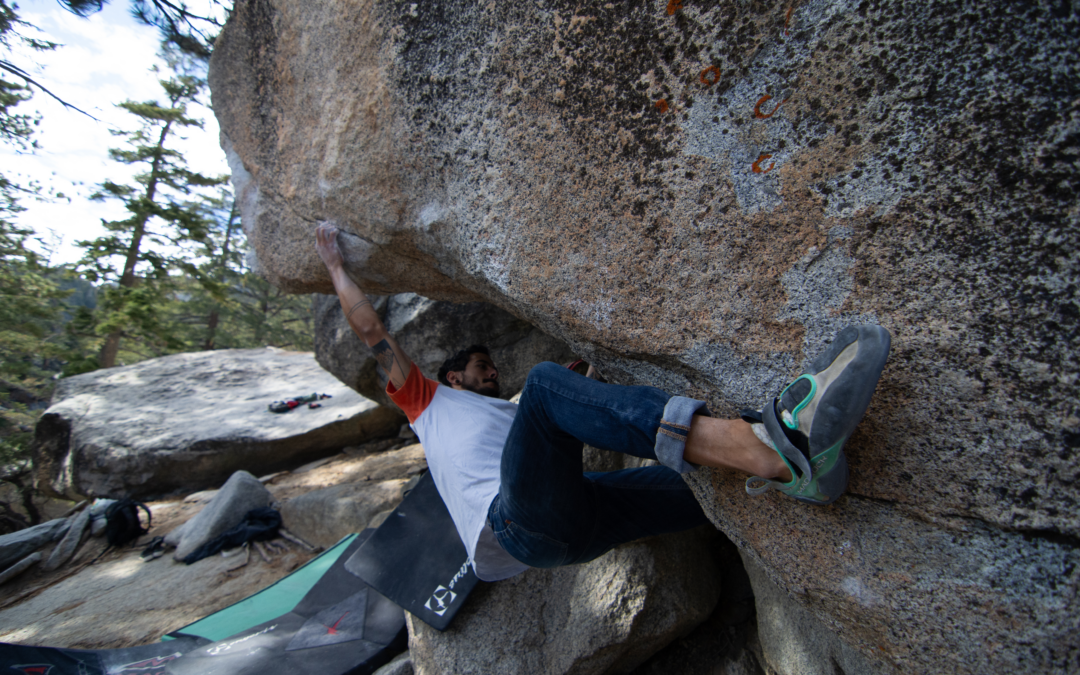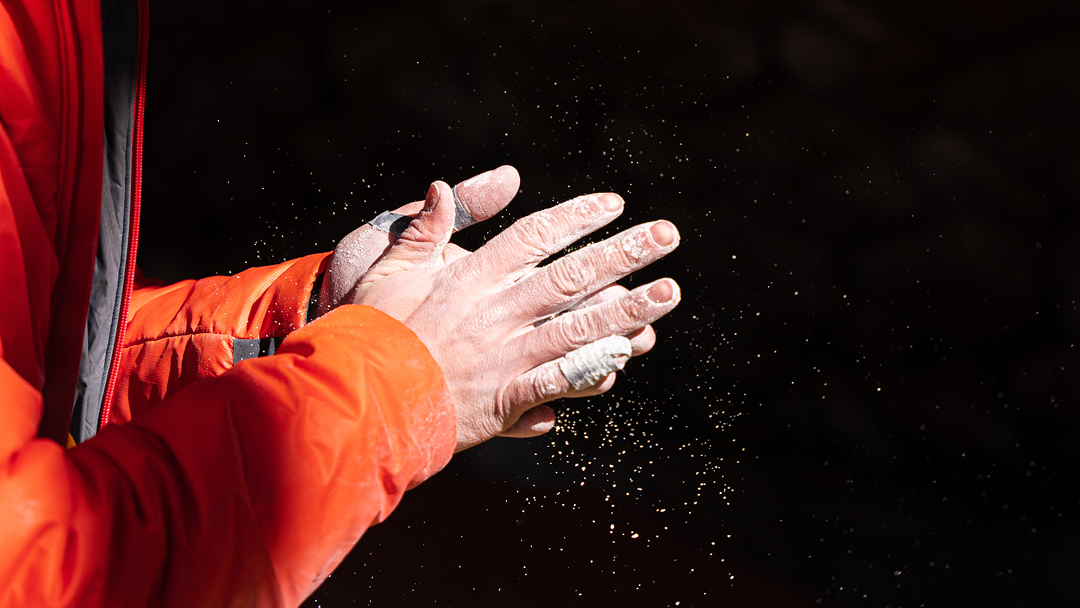Tramway Bouldering Overview
Palm Springs, California, might be famous for its desert heat, but just a tram ride away, you’ll find yourself in a world of towering conifers, ancient granite boulders, and crisp alpine climbing conditions. Welcome to Tramway bouldering, one of the most unique climbing areas in the U.S., where desert and high-altitude magic collide.
This guide contains everything you need to know, from classic problems to travel logistics and local tips.
Also, check out The Top 10 Most Popular Problems in Tramway! Or, watch the full video on YouTube.
Understanding Tramway Bouldering
Alpine bouldering in the middle of the desert sounds impossible, but the Palm Springs Aerial Tramway makes it a reality. The tram carries climbers from the scorching desert floor to crisp alpine air at over 8,500 feet of elevation.
The Tramway boulders, tucked within Mount San Jacinto State Park, offer some of the best granite problems in Southern California, especially when other zones are baking in the summer heat. Thanks to the high elevation, conditions stay cooler, providing a rare escape for summer climbing.
The Tramway isn’t just a climbers’ secret, either. It’s long been a major tourist destination, drawing visitors eager to ride the iconic tram, take in panoramic views, and explore the vast network of hiking trails in the state park. Since 2001, the tramway has operated one of the largest rotating tramcars in the world, offering a full 360° view of the rugged desert and alpine landscape as you ascend.
Whether you’re chasing shade for summer sends or enjoying a crisp fall session, Tramway combines world-class granite with unforgettable scenery, all just a tram ride away from Palm Springs.
Rock Type and Climbing Style
The boulders at Tramway are made of fine-grained granite, offering a mix of textured faces, edges, crystals, and occasional rails. The boulders are steep, and many problems involve overhung climbing on large features, with some compression lines and slabs mixed in. Though a few technical or vertical climbs exist, Tramway is best known for steep granite, overhung features, and dynamic movement. It’s a style that demands focus and finesse; perfect for climbers looking to sharpen their skills.
Best Times to Boulder in Tramway
The best season for bouldering at Tramway is late spring through fall; May to October is typically prime.
- Summer (June–September) is the peak season:
- While most of the Southern California desert roasts in triple-digit heat, Tramway’s high elevation keeps temps cooler and climbable.
- Daytime temps usually stay between 65°F and 80°F, which is as good as it gets in the summer season.
- Spring (April–May) and Fall (October–early November) are also excellent:
- Cooler temps, fewer crowds.
- Shoulder seasons offer a great mix of good conditions and mellow vibes.
- Winter (November–March):
- Be prepared for snow and freezing temperatures.
- Winter storms sometimes shut down tram operations temporarily, so check tram status if planning a winter visit.
- That said, during dry, sunny spells, some boulders melt out quickly and offer very crisp friction for winter sessions.
Essential Areas for Every Skill Level
Beginner-friendly Classics
Newer climbers will find plenty of approachable problems with good holds, flat landings, and engaging movement. A few easier classics are located close to the trail and make for perfect first sessions at altitude.
Emerald City V0— A friendly, entry-level highball. Start off a good low flake and climb up high to knobs and a lieback flake. Bring plenty of pads!
Hueco Shuffle V1— A great juggy warm-up. Sit start at the lowest hueco and climb the gently overhanging face through a big huecos to a jug then over.
Frank’s Roof V3— Sit start low off glassy lieback crack. Climb through the short roof with a big move to the lip. Then climb straight up from there. A harder, pumpier variation traverses the lip left to end on The Terminator V4.
The Terminator V2— Stand start on good holds with poor feet. Climbs pretty much straight up to good edges.
No matter where you start, climbing a high volume of problems in this grade range is one of the best ways to improve your granite technique, especially on the steep granite features that define Tramway’s style.
Intermediate Classics
The V4–V6 range features a ton of excellent climbs that blend classic Tramway movement on overhung features, rails, and body-tension-dependent sequences. This is the sweet spot for many climbers; challenging but approachable, with memorable lines and fun movement.
Paul Rocks V4— The most popular boulder in Tramway! Short and sweet, with a tricky sequence to reach jugs at the lip.
The Cube V5— Originally named “Dancing Queen,” this iconic blocky lowball overhang is now known as “The Cube”. Sit start low on a sidepull. Crank up left to slopers and then up to the blunt lip of the boulder. From there, traverse left and up. It’s a fight more than a dance, but it’s a classic.
The Swedge V5— This bizarre slice of granite leans against a tall cliff band with an obvious arete problem. Sit start low using the opposition of the two aretes. Ascend the climb until your wingspan gives up, then up the right side of the swedge to an exciting top out above.
Power Windows V6— Start low on a jug, pinch the arete with the left hand and crank out right to a sidepull under the overhang.
Hard Classics
If you’re chasing hard problems, Tramway delivers. The higher-end classics often require precision, tension, and bulletproof footwork. For those who love subtle granite puzzles, the upper grade range offers a rewarding test of skill and conditions.
Swing Dance V7— An area classic. Sit start on the horizontal jugs and traverse left along a line of edges and crimps, to gain the lip.
Greenpeace V8— Start standing matched on a sloping shelf with a gaston for the right hand. Climb up to the sloping lip and over.
Byron’s Roof V9— Established in the 90’s, this solitary roof problem has seen decades of ascents but it never seems to get any easier. Sit start off the long rail on the right side of the roof and shoulder through the roof to a crack at the lip. Exit up right into good knobs.
Extra-Hard Classics
Tramway offers a handful of test pieces in the V10+ range that demand precision, finger strength, and confident feet. These problems are fewer in number but high in quality and worth checking out if you’re up to it.
Steep Sharma Arete V10—Featured in Rampage, the iconic ’90s climbing film, this is an OG Chris Sharma FA. Start at a small dish under the overhang. Crank up to a blocky side-pull and dyno up to good holds.
Attack of the Staph Sit V11— Sit start at the bottom of the long diagonal crack with your right hand, and your left hand on the opposite side. Climb up the crack to join Attack of the Staph.
Somewhere in Time V12— Climb up a thin, steep crack. Core tension and crimp strength will help with this one.

Planning Your First Tramway Bouldering Visit
Tramway is a truly unique bouldering destination, but planning ahead will make your trip much smoother and more fun. Here’s what you need to know before you go:
🎟️ Buy Your Tram Ticket in Advance
The Palm Springs Aerial Tramway can get crowded, especially on weekends, holidays, and during the summer tourist season. Buying tickets online ahead of time guarantees your spot and helps you avoid long lines. Check the latest schedules, ticket prices, and any service updates before you go.
- Round-trip ticket: ~$34.95
- Parking fee: ~$15 at the tram base lot
Pro Tip: The tram cabins rotate as they ascend, offering 360° desert and alpine views. Pack light, carrying fewer crash pads makes boarding much easier.
🧭 Navigating to the Boulders
After exiting the tram and before you begin climbing, you must fill out a free climbing permit at the ranger station. Once you reach the top (the Mountain Station), follow the trail to Long Valley, where the ranger station is a short walk downhill.
From there, you can hike toward the different bouldering zones. Many classics are within a 10–20 minute hike, but some of the best problems require a little more walking.
Safety and Ethics Essentials
- Always fill out a free climbing permit at the Ranger Station before bouldering.
- At over 8,500 feet, the air is thinner than at sea level. Hydrate well, pace yourself, and expect to get tired faster than usual if you’re not used to the elevation.
- Afternoon thunderstorms can roll in quickly, especially in late summer. Always check the forecast before heading up and be prepared to leave early if the weather turns.
- Some landings are uneven or rocky. Multiple pads and good spotters are highly recommended.
- Dogs are not allowed deeper into the bouldering zones that border or cross into wilderness-designated trails, so you may want to consider leaving them home.
- Be respectful of other climbers and brush your tick marks!
Tramway Bouldering Conclusion
Tramway is one of the most unique bouldering destinations in the country, where high-alpine granite meets desert views, and crisp summer sessions are just a tram ride away. Whether you’re making a day trip from Palm Springs or planning a full weekend of exploring, the combination of quality rock, cool temperature, and scenic surroundings makes this place special.
Just remember: you’re climbing in a fragile alpine environment, so take the time to follow local ethics, pack out everything, and register at the ranger station. A little extra care goes a long way in helping preserve access for future seasons.
Check out the full Tramway Bouldering Guide on KAYA.








